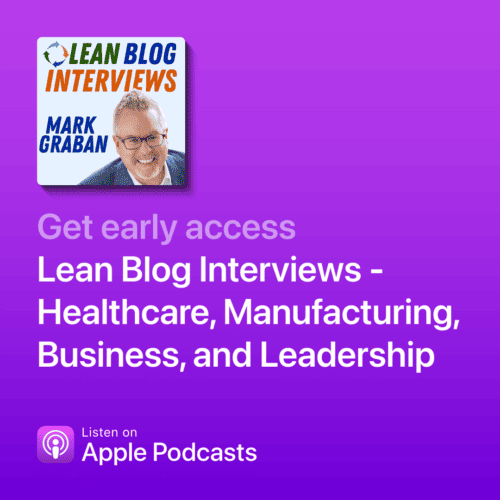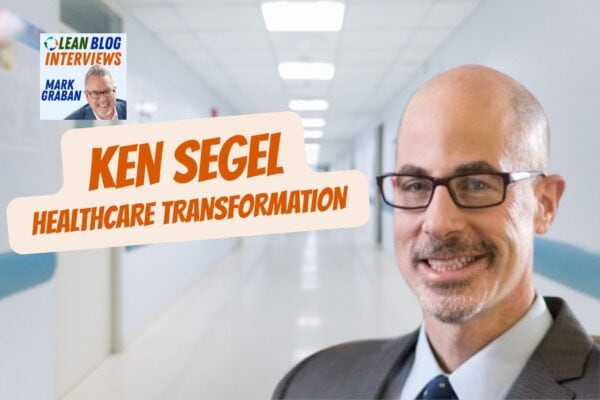Scroll down for how to subscribe, transcript, and more
My guest for Episode #530 of the Lean Blog Interviews Podcast is Ken Segel, Co-Founder and Chief Relationship Officer at Value Capture.
With over two decades of experience in healthcare improvement, Ken has been instrumental in guiding Value Capture's mission: helping healthcare organizations pursue habitual excellence by applying principles of safety, transparency, and systems thinking. In this episode, Ken shares lessons drawn from his unique and non-traditional journey–from public policy work in Washington, D.C. to transformative partnerships with industry icon Paul O'Neill and the Pittsburgh Regional Health Initiative.
Ken and I explore why world-class safety, quality, and financial performance can and must co-exist, and how starting with safety unlocks powerful learning across any organization. He reflects on how Paul O'Neill inspired leaders to set seemingly audacious goals like “zero harm”–not to punish failure, but to align people around shared purpose and continuous improvement. We also discuss the importance of creating a comprehensive operating system, one that fully integrates work systems, management systems, and improvement systems–not just Lean tools or events in isolation.
Listeners will learn why Ken believes deeply in the Shingo Principles, and why Value Capture remains the only Shingo Affiliate firm dedicated exclusively to healthcare. He also talks about the recent leadership transition at Value Capture, passing the CEO baton to longtime colleague Shanna Padgett. Whether you're a Lean healthcare leader or someone passionate about values-based leadership, this conversation offers rich insights into guiding with purpose, learning from failure, and building systems that support excellence for all.
Ken previously appeared on My Favorite Mistake (Episode 147), where he shared a powerful story about early-career lessons in leadership and systems thinking that helped shape his path into healthcare improvement.
Questions, Notes, and Highlights:
- Can you share your Lean origin story?
- (How did your unconventional path lead you into this work?)
- What was it like working with Paul O'Neill, and how did he influence your thinking?
- What was the vision and impact of the Pittsburgh Regional Health Initiative?
- Why was setting a goal of zero harm so controversial–and so powerful?
- How did leaders like Dr. Richard Shannon apply these principles to dramatically improve patient safety?
- Where do you see progress–and continued challenges–around transparency and safety sharing in healthcare?
- Why is safety such an effective entry point for broader transformation?
- How do you define a “comprehensive operating system” in a healthcare context?
- What's the difference between a management system and a full operating system?
- How can the Shingo principles support healthcare organizations on their improvement journey?
- What does it mean for Value Capture to be a Shingo Affiliate focused solely on healthcare?
- What advice would you give to a health system leader who thinks they already have a Lean system in place?
- Can you share the recent leadership transition news at Value Capture?
This podcast is part of the #LeanCommunicators network.


Full Video of the Episode:
Thanks for listening or watching!
This podcast is part of the Lean Communicators network — check it out!

Key Actionable Takeaways
Set aspirational goals without fear of failure.
Setting goals like “zero harm” isn't about perfection or punishment–it's about aligning teams toward a meaningful ideal and creating the conditions for learning, innovation, and continuous improvement.
Start with safety to drive systemic improvement.
Focusing on safety first–especially in healthcare–creates urgency, clarity, and shared purpose. It helps teams understand processes at a deeper level and lays the foundation for broader organizational excellence.
Build a truly comprehensive operating system.
A Lean daily management system alone isn't enough. Sustainable improvement requires integration of three systems: the work system, the management system, and the improvement system–guided by principles, not just tools.
Automated Transcript (Not Guaranteed to be Defect Free)
Mark Graban:
Hi, welcome to Lean Blog Interviews. I'm your host, Mark Graban. Our guest today is Ken Segel. He is a co-founder and the Chief Relationship Officer at the firm Value Capture. For more than two decades, Ken has helped shape Value Capture's DNA, and today, as Chief Relationship Officer, he cultivates executive partnerships, guides the firm's growth and marketing strategy, and coaches leaders who refuse to settle for average.
Ken and Value Capture believe that world-class safety, quality, and financial performance can and must co-exist. So Ken, welcome to the podcast. How are you?
Ken Segel:
Mark, I am not only very good, I'm really honored to talk with you today. I'm humbled that it's you, and also, the podcast record you've created here. It's great to be part of this learning community.
Mark Graban:
Well, I'm glad you're here. I emphasized “this podcast” because it was great having you on the My Favorite Mistake podcast, Episode 147. I encourage people to go listen to that. I thought it was a particularly compelling story and set of lessons learned. That story is also summarized in the book The Mistakes That Make Us.
And then we've talked–I don't know how many times–when I was hosting the Habitual Excellence podcast through Value Capture.
Ken Segel:
We did, absolutely, Mark. And The Mistakes That Make Us–actually, listeners, I had Mark sign a copy of that book, and I have a daughter that just graduated from college on Monday. I presented that to her as, I think, a meaningful kickoff gift for adulthood. I think you did us all a service in the community by pulling together the fundamental lessons in there–lessons that typically you don't learn, and that go against a lot of myths, but that are deeply embedded in how we in the Lean community think.
Mark Graban:
Well, thanks–and congratulations to your daughter. And thank you for being willing to share your stories. People who listen to those other podcasts know this is hardly our first conversation on these topics, but I think we have a lot to explore here today.
I'm not putting you on the spot, but you knew I was going to ask: can you share your Lean origin story–or however you want to frame it? I think your path into this work and passion is very non-traditional.
Ken Segel:
Very, very non-traditional. I got out of college thinking my job was to change the world, and the way to do that was through public policy–pulling big levers. I headed off to Washington and really enjoyed myself in the politics and policy-making world, and I was rising in that world. But I became disillusioned with trying to pull big policy levers and hoping everything would get better all at once. There seemed to be a lot of inherent waste in that process.
I ended up getting into healthcare philanthropy back in Western Pennsylvania, where I grew up, at a health foundation that was really interested in systems change. That led to an intellectual exploration and efforts to develop not just projects, but ideas and infrastructure that would allow things to stick systemically. I was headed off to business school at a fancy place when, through our work trying to develop health systems, we came in contact with a guy named Paul O'Neill, who was CEO of Alcoa.
Ken Segel:
As we tried to organize a more systemic approach to the healthcare system in Pittsburgh, Paul agreed to chair our effort. I thought he would just be a significant business leader with the gravitas to pull people together. But in fact, he was one of the great systems thinkers, doers, and leaders that, in my view, has ever existed.
I made a decision at that point that he would be my graduate school. I ended up getting an MBA but staying local and decided I would go to the school of Paul O'Neill. I had the fortune of helping him, Karen Feinstein at the Jewish Healthcare Foundation, and others organize the Pittsburgh Regional Health Initiative (PRHI).
Mark Graban:
Yeah, one of the great honors I've had hosting this podcast was the opportunity to speak with Paul O'Neill–Episode 124. I encourage people to go back and hear some of his thoughts directly. It's really powerful and still, of course, relevant. It's based on certain key principles that I know you and I share a deep belief in.
I first learned of PRHI probably around 2006 or 2007 when I was new to healthcare. There was a book and a DVD called The Nun and the Bureaucrat, produced by people connected to Dr. Deming's work. What I remember of PRHI is that it was an effort to drive actual sharing and collaboration within Pittsburgh–the idea that the community deserved the benefit of shared learning in safety and quality improvement. That it shouldn't be siloed to a single health system. Is that a fair recollection?
Ken Segel:
Yes, it was quite remarkable. Just for context: this was organized a full year before the Institute of Medicine's To Err is Human report came out. At that time, Western Pennsylvania was becoming intensely competitive in healthcare. The relationships between health systems had become extremely antagonistic. That hadn't always been the case, but it deeply affected relationships among physicians and groups.
It had gotten to the point where, when the region put together a broad economic strategy, healthcare wasn't even mentioned–even though it was one of the largest sectors. So Paul O'Neill stepped in, and rather than force people to do something, he raised their sights using principles we'd now associate with Toyota Production System, Shingo, and Lean.
He asked: “Isn't there something fundamentally important we can do together?” He emphasized that we should compete on what's appropriate to compete on–but that safety and quality learning should be openly shared. Then he pushed people to apply principles like transparency and rapid improvement, all grounded in respect for every individual.
Mark Graban:
That's still such a challenge, even today. Twenty-five years later, it's hard for many organizations to even spread learning unit to unit–let alone between hospitals. What helps organizations overcome that reluctance?
Ken Segel:
I think the healthcare community has made some progress. There's a growing openness to talking about harm and sharing results, especially in the Lean healthcare community. But globally, there's still a lot of fear-based response and defensiveness–especially around transparency.
We still see too much focus on sharing solutions instead of sharing the problems and their root causes. There's often a lack of vulnerability. But in places where leaders embrace these principles–where they lead with purpose, transparency, and urgency–the results can be dramatic.
Right now, we're working with an academic medical center. Just three months in, after engaging with these ideas and applying them with leadership commitment, they've already cut their harm rate by over a third. That's the power of leadership choosing to model transparency and respect, even when it makes lawyers uncomfortable.
Mark Graban:
One of the early examples of applying breakthrough thinking to safety was Paul O'Neill's influence on Dr. Richard Shannon, when he was at Allegheny in Pittsburgh. If I remember correctly, they saw an immediate and dramatic reduction in hospital-acquired infections–like CLABSIs–on the order of 90%. Is that right?
Ken Segel:
Yes, absolutely. And some backstory: Dr. Shannon, who later went on to be Chair of Medicine at Penn, EVP at UVA Health, and now Chief Quality Officer at Duke, was at that time Chief of Medicine at Allegheny General–the largest hospital in Pittsburgh. That hospital, incidentally, is the fictional setting of the HBO Max show The Pitt.
Dr. Shannon was sent to some PRHI organizing meetings to defend the hospital's reputation–there were concerns about outcomes data in cardiac surgery. But when he got there and saw that this wasn't a punitive or blame-focused effort, he flipped. He became a champion of the ideas–combining clinical excellence with operational excellence.
In the ICU, they achieved dramatic reductions in CLABSI and CAUTI. He and others demonstrated that zero was not only theoretically possible, but actually achievable. They also did cost modeling to show CFOs that even though infections seemed profitable on paper, preventing them actually saved more money overall. That helped build momentum and credibility.
Mark Graban:
Yeah, I've used that chart many times–the one showing Alcoa's huge reduction in employee harm along with a sharp increase in stock price. That's proof of the idea that there doesn't have to be a trade-off between safety and financial performance.
Ken Segel:
That chart is powerful. Paul O'Neill showed us that safety could be the strategic lever that transforms everything. He used to say: the goal is zero harm, and while we don't yet know how to get there, I believe in all of us working together to figure it out.
I remember a pivotal moment in PRHI when the group debated whether the goal should be zero. Some physician leaders pushed back, saying it might expose Paul as naive. One intensivist said, “We don't even know the science that would allow us to prevent all of this yet.” And Paul lit up. He said, “Great! Then let's be the community that figures it out. Let's rally researchers, organize studies, and close those knowledge gaps.”
That moment shifted the energy in the room. Instead of resisting, people got excited. That's what Paul did–he pulled people toward aspiration and learning, rather than pushing them through mandates.
Mark Graban:
That's leadership. Not top-down control, but inspiring people to think bigger. It's that blend of humility and direction-setting–leaders saying, “Here's where we're going,” but also, “I don't have all the answers, and I need you.” It's servant leadership, systems thinking, and a deep respect for people.
Ken Segel:
Exactly. Paul believed leaders must set the aim–like zero harm–but the “how” has to be discovered together. He demanded excellence, but he also created systems to make it possible. At Alcoa, accountability didn't go away–it shifted. Leaders were accountable not just for outcomes, but for how they led people, solved problems, and shared learning.
What wasn't acceptable was hiding problems, hoarding knowledge, or behaving disrespectfully. There was real accountability for operating within the business system, which had roots in TPS and focused deeply on safety. And Paul would say: “You have to free people from blame for problems so they're free to work on solving them.”
Mark Graban:
I think one of the key principles Paul O'Neill helped articulate is the idea that we don't need to accept trade-offs–between safety and financial results, or quality and efficiency. And safety is such a powerful entry point. Can you talk more about why starting with safety is so effective?
Ken Segel:
We've seen this work again and again. Safety is the ideal leverage point for transformation because it accomplishes several things at once. First, it's deeply human. Everyone understands why safety matters. It engages people at a purpose-driven level that transcends individual roles.
Second, it's measurable. You can track harm, near-misses, events. And in organizations that take it seriously, there are standards–and consequences–for misreporting. So it brings a degree of clarity and accountability.
But most importantly, you can't improve safety without deeply understanding your processes. It forces leaders to go to the front lines, to engage with how work is really being done, and to support that work. That's where Lean begins–at the process level.
Improving safety forces you to engage people, build problem-solving capability, and make systems more transparent. It teaches the disciplines and habits needed for sustained improvement. It's not about everything, everywhere, all at once. It's a way in. And once organizations learn to solve safety problems, they build muscle to tackle bigger challenges.
Mark Graban:
And it creates that cultural infrastructure. I know you use the term “habitual excellence.” Can you explain that idea, and how it's tied to what you're describing?
Ken Segel:
“Habitual excellence” means building a culture and system where excellence becomes the natural state. It's not about heroic efforts–it's about reliable, reproducible behaviors across the organization.
Organizations that take this seriously find themselves more agile and more resilient. Especially now, when the healthcare environment is so turbulent, those that have been on this path for a few years are incredibly grateful. They have execution capability. They know what their North Star is, and they can pivot strategy as needed without losing purpose or stability.
One of the things Paul O'Neill emphasized that I think Lean communities sometimes underemphasize is the need for something that involves everyone from the start. Model cells are great, but they're not enough. From day one, everyone should understand that they're part of the improvement journey. That's what safety does–it includes everyone.
Mark Graban:
Let's talk more about the Shingo Institute. Value Capture is a Shingo Affiliate–still the only one focused exclusively on healthcare, right?
Ken Segel:
That's right. There are other affiliates that do great work in healthcare, but we're the only one whose mission is wholly dedicated to health and healthcare.
Being a Shingo Affiliate means we're part of a global learning network centered on deeply researched principles of operational excellence. The Institute is based at Utah State University, and they offer a rigorous framework–not a set of tools, but principles that organizations can apply within their own context.
We teach a sequence of workshops that begin with an overview of the principles, and then help organizations see how those principles manifest in real systems–at host organizations that have embraced them. Or we deliver those workshops inside organizations, building capability locally.
But the real key is leadership. When executive teams participate, not just process improvement staff, that's when the magic happens. The Shingo framework helps leaders see their own systems differently–and guides them to create alignment, consistency, and purpose.
Mark Graban:
Let's dig into the phrase “comprehensive operating system.” Some people call it a Lean operating system or a Lean management system. What do you mean by that, and how would you explain it to a health system executive at a conference?
Ken Segel:
Let's assume we're at a Lean healthcare conference, and someone says, “Well, we already run a daily management system. What are you talking about?”
One of the things we've observed over the last decade–something that really crystallized for us about two and a half years ago–is that healthcare has fallen in love with a part of a Lean operating system: the management system. Particularly the visual tools and daily tiered huddles. That's valuable, but it's not the whole picture.
We're not seeing enough development or integration of the work system and improvement system, which are equally essential. A complete Lean operating system embeds principles into how clinical care flows are set up and managed, how improvement happens, and how leadership supports and reinforces both.
A lot of organizations still rely on their Process Excellence team to drive Lean work. That's a sign that Lean isn't fully embedded. The mindset needs to shift: it's the operating leaders–your CNO, CMO, service line leaders–who should be shaping and owning these systems. The work system has to reflect flow, purpose, and built-in problem solving. And the improvement system should help people address issues both systematically and continuously.
Mark Graban:
So, management system ≠ operating system.
Ken Segel:
Exactly. And Shingo has provided a very useful way to understand this. They teach that every organization functions through three key systems: the work system, the improvement system, and the management system. Sometimes people debate whether strategy is a fourth or a component of the improvement system–it doesn't really matter. What matters is integration.
In healthcare, there was a lot of early focus on kaizen events–trying to fix parts of the work system. Then people realized events weren't enough. Places like ThedaCare, with support from our team and others, pioneered Lean daily management systems. That helped reinforce discipline and alignment, and it worked. But then too many systems neglected ongoing development of their work and improvement systems.
Daily management can't replace deep capability for value stream design, process stability, or embedded problem solving. A truly comprehensive system requires all three–work, improvement, and management–each built on principles, not just tools.
Mark Graban:
And the goal is to rebalance and integrate those systems, right?
Ken Segel:
Yes, that's exactly what we're working toward. Helping organizations rebuild capability where it's thin and tie everything together. When you integrate the systems, you create alignment between purpose, behaviors, and results. That's what enables long-term, sustainable excellence.
Mark Graban:
So to summarize as we wrap up here–and again, we've been joined by Ken Segel from Value Capture–I hear you clearly saying that an operating system and a management system are not the same thing. I'll point people to search for “Value Capture three systems”–work system, improvement system, management system–as a useful framework.
Ken Segel:
Yes, and to be clear, that's the Shingo model–we didn't invent it. We're trying to help people adopt and apply it in healthcare settings.
Mark Graban:
There's a lot we can continue exploring–hopefully in a future episode–about unpacking those systems further. We're running a little short on time, but this has been a rich discussion. I appreciate the stories, the examples, and everything you've shared, Ken.
I also wanted to give you a moment to share some news that's already been announced publicly: a leadership transition at Value Capture.
Ken Segel:
Yes, a couple of months ago, we completed a long-planned generational leadership transition at Value Capture. I was proud and excited to hand off the CEO role to Shannon Paget, who has been our Vice President for nine years. She is remarkable and already has us on a faster improvement journey ourselves, which is exciting.
Mark Graban:
That's great to hear. Shannon was actually my first “healthcare improvement buddy” back in August 2005 when we worked together at a client site. I'll reach out to her and hopefully have her as a future guest on this podcast.
Ken Segel:
That would be wonderful. Shannon is a longtime colleague and friend of yours, and it's absolutely a step up in quality for Value Capture.
Mark Graban:
Well, thank you again, Ken. I appreciate the thoughtful conversation, the historical perspective, and the practical insights. Thanks for being here.
Ken Segel:
Thanks for having me, Mark. Great to see you.
Please scroll down (or click) to post a comment. Connect with me on LinkedIn.
If you’re working to build a culture where people feel safe to speak up, solve problems, and improve every day, I’d be glad to help. Let’s talk about how to strengthen Psychological Safety and Continuous Improvement in your organization.









